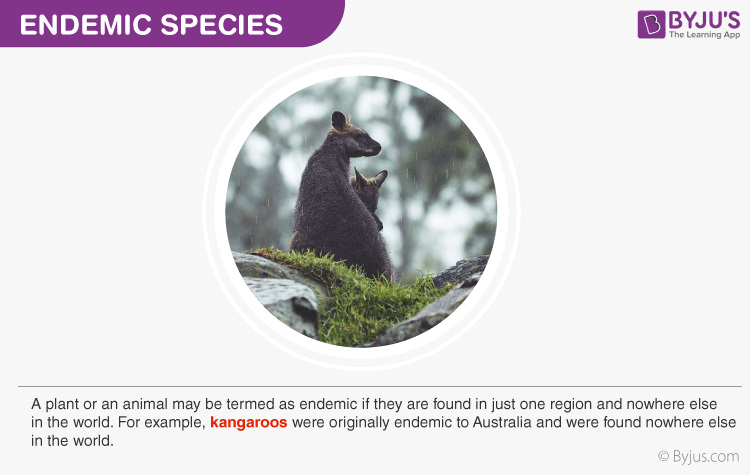Endemic Species Definition
“Endemic species is that ecological state of a species where a species is unique to a defined geographical location.”

What is Endemic Species?
Endemic species are those that are found in just one region and nowhere else in the world. For example, kangaroos are originally endemic to Australia and are found nowhere else in the world. The cases where they have been spotted outside their natural habitat is due to humans introducing them when the animal was in captivity.
There are also other marsupials that are endemic only to Australia and its surrounding islands. The Tasmanian Tiger is one such animal that was endemic to Australia, Tasmania and New Guinea. But now, it is extinct.

As stated above, endemic species are those which are only found in a given region or location and nowhere else in the world. However, since endemic species are unique to a particular geographical region; they are more vulnerable to extinction. As a result, special efforts may be required to conserve them.
Also Read: Endangered Species
Examples of Endemic species
There are several ways in which a species may come to be endemic to a particular area. A broadly distributed population may disappear from several habitats due to changes that have occurred in their natural habitat. The changes could be an influx of predators, human activities, climate change or a combination of these factors.
All other organisms of a species that were widely distributed around the world start to die out until the species becomes forcefully restrained to just one region.
For example, Endemic species, such as the tortoises of the Galápagos and the lemurs of Madagascar can be found on small islands. Big islands also provide the same isolation but on a larger scale.
Antarctica, Hawaii and Australia are all huge land masses where we can find a lot of endemic species. For instance, Kangaroos are endemic to Australia and polar bears are endemic to the Arctic.
In the case of endemic plants, sometimes, species become endemic due to habitat destruction. The Redwood Forest on the West Coast of the United States has become endemic as it is now almost entirely limited to California. While there was a time when Redwoods used to cover much of the United States but have been destroyed by logging and are now limited to a small conservation area.
Diseases, on the other hand, can also be endemic. An endemic disease may be geographically isolated or it may be isolated to a certain group. Malaria is an example of an endemic disease because it is mostly limited to small pockets of infection in Africa.
Endemic Species of India
A list of the endemic species of India is mentioned below:
Asiatic Lion, Gir Forest
Asiatic Lion is also known as the Indian Lion and can be only found in and around Gir Forest National Park of Gujarat. These are listed as endangered species. These are one of the five big cats found in India, the others being Indian Leopards and Bengal Tigers.
Kashmir Stag, Kashmir Valley
Also known as Hangul, the Kashmir Stag is found in the dense forests of Dachigum National Park, Kashmir Valley and Chamba district, Himachal Pradesh.
Lion-Tailed Macaque, Western Ghats
It is the rarest, most threatened and endangered primate species found only in the Western Ghats of Southern India.
Purple Frog, Western Ghats
The purple frog, also known as the Pignose frog, is only found in the rainforests of western ghats in India. It spends most of its life underground.
Sangai Deer, Loktak Lake
It is also known as Brow Antlered Deer exclusively found in Keibul Lamjao National Park of Manipur. This park is a marshy wetland located in the southern parts of Loktak lake.
Nilgiri Tahr, Nilgiri Hills
It is a wild sheep species, endangered and endemic to the Nilgiri Hills of Western Ghats.
Other endemic species of India include:
- Pygmy Hog, Assam
- Bronzeback Vine Snake, Western Ghats
- Nilgiri Blue Robin, Nilgiri Hills
- Malabar Civet, Western Ghats
- Anaimalai Gliding Frog, Anaimalai Hills
- Namdapha Flying Squirrel, Arunachal Pradesh
- Indian Giant Squirrel
- Bonnet Macaque
Also Read: Concept of Species
To learn more about what is endemic species, endemic species of India, and examples of endemic species, keep visiting BYJU’S website or download BYJU’S app for further reference.
Frequently Asked Questions
What are endemic species?
Endemic species are plant and animal species that are found in a particular geographical region and nowhere else in the world. Some species are endemic to a continent while others can be endemic to an island. E.g., Lemurs of Madagascar and Tortoises of Galapagos.
Name some endemic species of India.
Asiatic Lion in Gir Forest, Lion-tailed Macaque in Western Ghats of India, Nilgiri Tahr, Malabar large spotted civet, Nilgiri Blue Robin, Jerdon’s Corser, Nilgai, Nicobar megapode are some of the species of animals endemic to India.
Name some plant species that are endemic.
Some of the endemic plant species include- Nevada primrose, Waxflower, Pennell’s whitlow grass, Intermountain wavering, Mt. Wheeler sandwort, etc.
What is the difference between endemic and exotic?
Endemic species are the ones that belong to a particular area, whereas, exotic species are those which belong to some other region but are introduced in a foreign region. Endemic species are restricted to a particular area whereas exotic species are not.
How are native species different from endemic species?
A native species is not necessarily restricted to its native area. It may be found in other areas of the world as well. On the contrary, the endemic species is specific to a particular region and is found nowhere else.
What is the main risk associated with endemic species?
The main risk associated with endemic species is that they are more vulnerable to extinction. Since they are rare, the destruction of their habitats would reduce their population drastically.
How are endemic species important?
The endemic species are important to maintain a balance in the ecosystem. A balanced ecosystem purifies the environment and provides us with fresh air to breathe. When an endemic plant species becomes extinct, it takes with it around 10 to 30 endemic animal species. They are the focus for the conservation of biodiversity.
What do you mean by endemism?
Endemism is the condition of being endemic or being restricted to a particular geographical region. It describes the distribution of a group of species.

BEST ANSWER